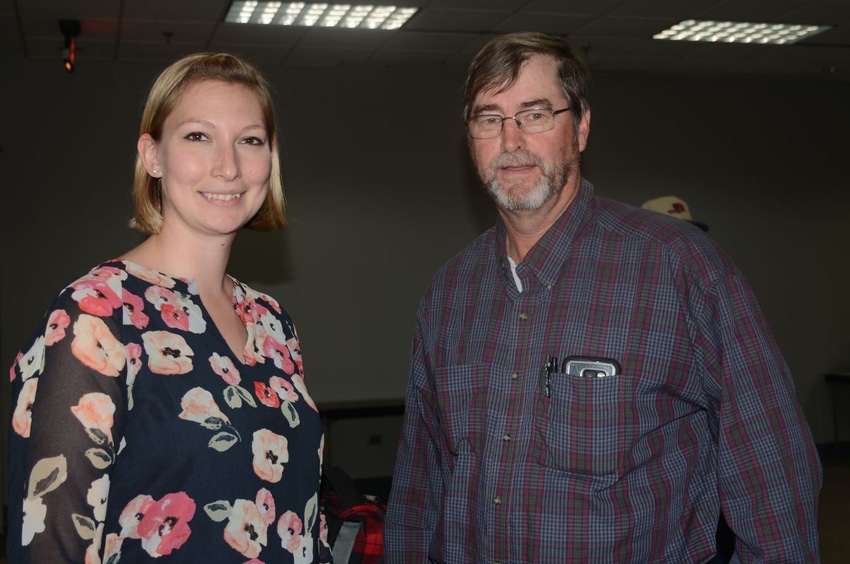
Both Clemson University and North Carolina State University are issuing warning bells for nematodes in the Carolinas.
The nematode issue was front in center at both Clemson’s corn and soybean production meeting in Dillon, S.C., Feb. 8 and at N.C. State’s Road Show production meeting the following day in Plymouth, N.C. A concern in both states is the Southern root knot nematode and the soybean cyst nematode.
Both John Mueller, Clemson Extension plant pathologist and director of the Edisto Research and Education Center, and Lindsey Thiessen, N.C. State Extension entomology and plant pathology specialist, said variety selection is job one for nematode control. Both specialists encouraged farmers to turn to soybean varieties that offer nematode resistance.
“We need to do a really good job of choosing varieties, and you need to identify the highest probability problems that you have, whether it’s a fungal disease or a nematode,” said Mueller at the Clemson meeting. “For soybeans, you need to find the variety that is resistant to the nematode species that you think you have such as root knot nematode resistant or soybean cyst nematode to be successful.”
N.C. State’s Thiessen echoed Mueller’s advice, emphasizing host resistance as the best defense against soybean cyst nematode because it is the cheapest thing farmers can do. “Pick a variety that has resistance to soybean cyst,” she said at the Plymouth meeting.
Mueller and Thiessen expect root knot nematodes to be a bigger pest this year and in the future. The challenge is there are many different species of root knot nematodes with Thiessen pointing to at least five known species in North Carolina.
“These species have wide host ranges,” Thiessen said. “They can survive on different weeds and on rotational crops. Southern root knot nematode is generally our most pervasive species.”
In South Carolina, Mueller sees the Southern root knot nematode as the biggest nematode concern in soybeans. “If I had one choice in a soybean variety, the one thing I’d look for would be resistance to root knot nematode. That would be where I would start. If you can eliminate that as a problem from your field, you’re probably moving forward pretty good,” he advised.
Mueller and Thiessen emphasized the importance of rotations in controlling nematodes. Mueller said nematodes build up in continuous soybeans while Thiessen said rotations are the best bet for soybean cyst nematode control.
“I think people are doing a great job with this. We’re not seeing too many losses from soybean cyst and that’s very promising,” she said.
Mueller emphasized one universal truth about nematodes no matter the species of nematode or the crop grown: a good healthy tap root is vital.
“Most of these crops are going to put out a good healthy tap root in four to five weeks, so our goal is one way or the other to protect that tap root,” Mueller said. “A gall on a tap root means that everything below that gall means you have restricted the water flow up. Galls on side roots don’t do a lot of damage, but if you have a gall very high on a tap root, you’ve essentially reduced the efficacy of all those roots below it.”
To ensure healthy tap roots, Mueller said farmers can use nematicides, in furrow fungicides or seed treatment fungicides. And both Mueller and Thiessen emphasized the importance sampling at the end of the year to determine what the nematode populations are in a particular field.
Thiessen noted that corn can be a host to root knot nematodes and the pest can reproduce on corn. She said grain sorghum and wheat are good rotations because they aren’t great hosts for root knot nematodes.
Still, Thiessen said the best thing farmers can do to fight nematodes is good cultural management by maintaining good plant health. Sanitation is vital.
“The best defense against having a pathogen come into your field is to not get it in the first place. If you have a clean field, don’t transfer from your dirty field to the clean field. Make sure you are either plowing up your infested field or you rinse your equipment between fields that you know are a problem,” Thiessen said.

John Mueller, Clemson University plant pathologist and director of the Edisto Research and Education Center, says root knot nematodes are a real concern for South Carolina farmers. Mueller spoke at the Clemson corn and soybean production meeting at the Dillon Community Center in Dillon, S.C.
About the Author(s)
You May Also Like






